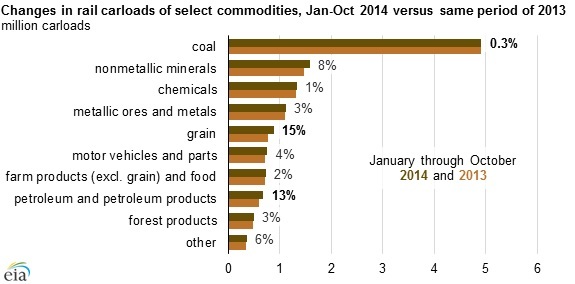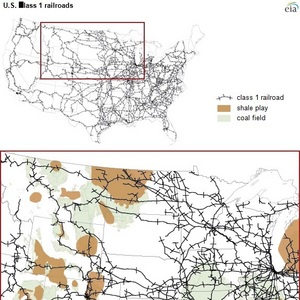EIA: Rail traffic up 4.5% from last year



U.S. Energy Information Administration
November 13, 2014
BY U.S. Energy Information Administration
U.S. rail traffic, including carloadings of all commodity types, has increased 4.5 percent through October 2014 compared to the same period in 2013. Crude oil and petroleum products had the second-biggest increase in carloadings through the first 10 months of this year, with these shipments occurring in parts of the country where there is also strong demand to move coal and grain by rail. In response to shipper concerns over the slow movement of crude oil, coal, grain, ethanol, and propane, federal regulators are closely tracking service among the major U.S. freight railroad companies.
Rail carloadings of oil and petroleum products totaled 672,118 tank cars during January-October 2014, 13.4percent higher compared to the same period last year, according to the Association of American Railroads . Rising U.S. crude oil production, particularly in North Dakota's Bakken Shale formation, where pipeline takeaway capacity is limited in moving the state's growing oil volumes to market, is one of the main reasons for this increase in rail shipments of petroleum and petroleum products.
Advertisement
Advertisement
Rail shipments of coal were up a relatively small 0.3 percent during the same period, but coal is still by far the largest commodity volume moved by rail, with 4.9 million carloadings. Power plant operators are seeking more coal deliveries by rail to rebuild their coal stockpiles, which were drawn down during last winter's colder-than-normal weather. Rail also moves U.S. coal to various points for export. At the national level, coal exports were down nearly 16 percent during the first half of this year, but coal exports from the Seattle Customs District (mostly sourced from Wyoming's Powder River Basin) were up 2.4 percent during the first half of 2014.
Increased movement of grain represents the biggest commodity increase in rail traffic so far this year, up about 15 percent to 878,824 carloadings, according to AAR. The USDA forecasts a record harvest of corn and soybean crops this year. Harvesting of these crops is well underway in the major growing areas in the northern Great Plains states, according to USDA's crop progress reports.
Advertisement
Advertisement
On October 22, the U.S. Department of Transportation's Surface Transportation Board began requiring major freight rail carriers to file weekly updates on their service performance in delivering goods and commodities. These filings will lead to a better understanding of commodity movements by rail and the potential issues associated with increased demand from multiple types of commodities.
Related Stories
The U.S. EPA on July 8 hosted virtual public hearing to gather input on the agency’s recently released proposed rule to set 2026 and 2027 RFS RVOs. Members of the biofuel industry were among those to offer testimony during the event.
The USDA’s Risk Management Agency is implementing multiple changes to the Camelina pilot insurance program for the 2026 and succeeding crop years. The changes will expand coverage options and provide greater flexibility for producers.
EcoCeres Inc. has signed a multi-year agreement to supply British Airways with sustainable aviation fuel (SAF). The fuel will be produced from 100% waste-based biomass feedstock, such as used cooking oil (UCO).
President Trump on July 4 signed the “One Big Beautiful Bill Act.” The legislation extends and updates the 45Z credit and revives a tax credit benefiting small biodiesel producers but repeals several other bioenergy-related tax incentives.
CARB on June 27 announced amendments to the state’s LCFS regulations will take effect beginning on July 1. The amended regulations were approved by the agency in November 2024, but implementation was delayed due to regulatory clarity issues.
Upcoming Events










